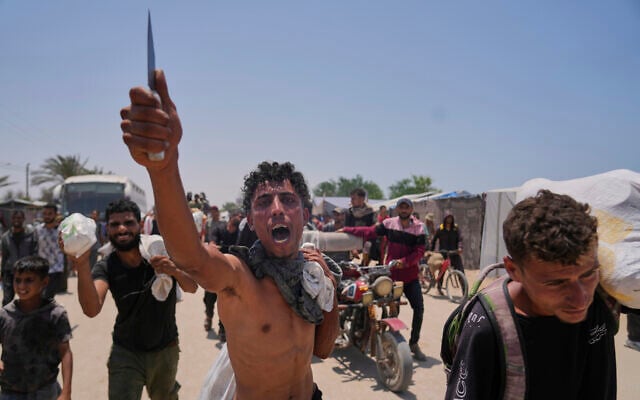
| Published June 13, 2025
US-and-Israeli-backed aid agency accuses Hamas of blocking its employees from receiving treatment after attacking them, as terror group says 21 aid-seekers killed by IDF
American-backed Gaza Humanitarian Foundation (GHF) has been distributing unprecedented volumes of aid in southern Gaza, operating independently of traditional UN channels even as its efforts face deadly attacks and militant opposition. The recent push comes in response to acute hunger after a prolonged blockade, with GHF claiming record numbers of meals delivered and raising questions about security and neutrality.
Since its launch in late May, GHF set up several large aid distribution hubs, secured by U.S. contractors and Israeli forces, aiming to feed Gaza’s most vulnerable. Despite initial logistical challenges and chaotic scenes at sites near Rafah, the foundation reported delivering as many as 2.6 million meals in a single day . Its first field director resigned, citing concerns over adherence to humanitarian principles.
On June 12, a GHF bus transporting aid workers was ambushed in southern Gaza, killing at least eight staff and injuring others in an attack the foundation attributes to Hamas militants. In contrast, Hamas police reported killing 12 members of an Israeli-backed militia linked to the same humanitarian convoy. Independent verification remains limited due to ongoing communications blackouts .
Meanwhile, Israeli military operations have intensified around aid sites. In 24 hours, over 100 Palestinians were reportedly killed and 400 wounded—including 21 near GHF locations—while internet disruptions further hamper coordination efforts.
A Palestinian waves a knife and shouts to the camera in Arabic, ‘We get food with the taste of death and blood,’ as he carries a bag containing food and humanitarian aid packages delivered by the US- and Israel-backed Gaza Humanitarian Foundation in Rafah, southern Gaza Strip, June 10, 2025. (AP Photo/Abdel Kareem Hana)
Here are the implications of the humanitarian developments and violence in Gaza as described in the sources:
-
Humanitarian Operations as Political Flashpoints
The targeting of aid workers and the dual identities of some actors blur the line between relief and resistance, making humanitarian missions politically charged and militarily vulnerable. -
Challenges to Neutral Humanitarian Access
GHF’s operations—backed by U.S. and Israeli forces—may be perceived as partisan, raising concerns about impartiality and further complicating access for other humanitarian agencies. -
Escalation of Armed Responses by Non-State Actors
The ambushes and militant responses highlight how non-state groups like Hamas may see certain aid efforts as threats to local authority or sovereignty. -
Increased Civilian Risk in Conflict Zones
Violence near aid sites puts already-vulnerable populations at further risk, especially when distribution centers become targets or are militarized. -
Erosion of International Humanitarian Norms
The overlap between aid delivery and military or intelligence efforts may erode long-standing norms that protect aid workers under international law. -
Complication of Israel’s Operational Narrative
Conflicting reports—between Hamas claiming to target militia and Israel framing it as an attack on aid workers—reflect the propaganda war that runs parallel to the physical conflict. -
Pressure on Multinational Aid Coordination
The rise of independent aid groups like GHF complicates coordination with UN agencies and NGOs, potentially creating duplication, confusion, or operational gaps. -
Strain on U.S. Diplomatic Position
The U.S. role in backing GHF could expose Washington to criticism over perceived militarization of humanitarian aid, affecting its influence in peace negotiations. -
Use of Aid Routes for Intelligence and Security Operations
Allegations of militia activity under the guise of humanitarian work may increase suspicion and justify more aggressive scrutiny or even attacks from local forces. -
Potential Legal and Ethical Backlash
If aid personnel are proven to be involved in security operations, or if aid is used as cover for intelligence gathering, it could result in international legal consequences or loss of trust in global humanitarian systems.
Overall Takeaway:
The situation in Gaza reveals a dangerous intersection between humanitarian aid, armed conflict, and competing narratives. As American-backed efforts like GHF operate amid militant attacks and political volatility, the line between relief work and military strategy becomes increasingly blurred—raising risks for civilians, complicating diplomacy, and challenging the credibility of international humanitarian norms.
SOURCES: BREITBART – American-Backed GHF Opens Aid Sites Despite Hamas Attack; Record Number of Meals Delivered
THE TIMES OF ISRAEL – Hamas police says it killed 12 members of Gaza’s Israeli-backed Abu Shabab militia
REUTERS – Humanitarian workers killed in Gaza ambush blamed on Hamas; internet cut in territory






Be the first to comment